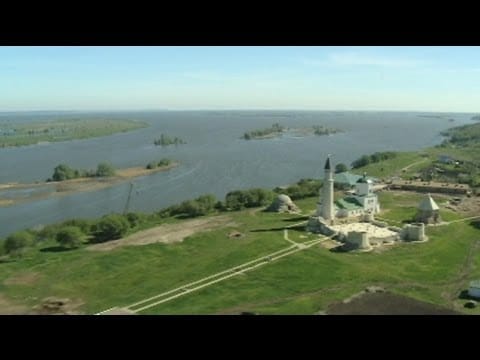On the banks of the Volga river, in the very heart of Russia, the republic of Tatarstan has reunited two religions in its history.
Throughout the ages, explorations and wars along the Volga (Russia’s largest river) have shaped the destinies of this truly diverse place; as Yevgeniya Novikova, a Tatarstan tourism expert explains:
“The Volga helped us to conquer new lands in the Middle Ages and its importance as a connecting thread between the centuries and civilisations, between the people, cultures and religions of those who live on its banks, is invaluable.”
Although the river remains a major transport artery its waters still pose a risk. Only last year, a river boat cruise sank on the Volga, killing 122 people.
“They check all the vessels – their technical condition, the engines, hulls, fire safety of any and all ships that sail on the Volga.” said Yevgeniya Novikova.
The Tatarstan factfile
- The Republic of Tatarstan, a federal subject of Russia, is located approximately 800 kilometers east of Moscow
- Its area is 68,000 km2; population 3,786,488
- Among the residents, there are around two million ethnic Tatars, a million and a half ethnic Russians and significant numbers of other ethnic groups
- Spared of any significant inter-religious confrontation, Tatarstan sees itself an example of successful multiculturalism
- Kazan, the capital city of Tatarstan, is one of Russia’s largest and most prosperous cities; it’s known as the “Third Capital” of Russia after Moscow and Saint-Petersburg
The Volga has played a unique role in Tatarstan’s history. When the Russian Tsar Ivan the Terrible conquered Kazan in the 16th century, he did it by using the small island of Sviyazhsk. It lies just upstream from the Tartar capital and was a springboard for his attack. Spearheading Russia’s military and cultural arrival.
Father Superior Siluan, from the Assumption Monastery illustrates the nature of religious tolerance in Tartarstan:
“Modern Tatarstan is, of course, a combination of two cultures, the Russian Orthodox culture and the Islam-based Tatar culture. At the same time it’s clear that these two cultures don’t merge into a single one – they remain separate while enriching each other, as has always been the case, a peaceful co-existence.”
Bare church walls and decaying frescoes are the legacy of the Soviet era. When many of the island’s historical buildings were demolished, others were turned into Gulag prisons or storehouses.
Valeriy Kosushkin is a Fine art restorer: “For a period, this cathedral was used as a warehouse for grain and salt, which contributed to its degradation. And then, for a long time, it was simply abandoned.”
Today, massive restorations are bringing the 16th century island town back to life. After decades of oblivion, Sviyazhsk is once again a national history reserve, a window to the past.
Almaz Kazakov, a Blacksmith agrees: “Many crafts have unfortunately been forgotten and here anyone can try to forge the metal, to fashion clay into a pot or to weave a basket.”
Just a few hundred kilometres downstream, the Volga takes you to another ancient town. Bolgar, is the capital of the Tatars’ historical ancestors, who converted from paganism to a new religion, brought by Arab missionaries in early 10th century.
Liliya Safina, Deputy director at The Bolgar Memorial Estate talks to euronews:
“Ancient Bulgars adopted a religion that was new to them – Islam. From this exact place and time Islam started to spread throughout Europe and Siberia.”
The mighty Volga Bulgaria controlled much of the trade between Europe and Asia before its decline in the 13th century. Today, the remains of mosques, mausoleums, courthouses and baths are becoming a pilgrimage site for religious followers and archaeologists.
Liliya Safina concludes:
“Both of our republic’s unique heritage sites – Bolgar and Sviyazhsk, are being restored and revived so that we can preserve and study the monuments of the two religions that have been co-existing in our land for centuries, side by side.”
Traveler’s diary: Tatarstan
As we arrived in Kazan, we found a city-scale construction site: the Tatar capital is getting ready to host a series of international sporting events (2013 Summer Universiade, 2015 World Aquatics Championships and 2018 FIFA World Cup) that should help the republic rise to prominence – bringing more visitors to this picturesque Volga region in the process.
For Tatarstan, it’s an opportunity to promote its traditional heritage and its experience of sustaining a genuinely, multicultural society with little or no conflict between its ethnic and religious groups.
For one of the most urbanised regions of Russia, Tatarstan hasn’t forgotten its historical roots. In the centre of Kazan, the republic’s capital, we came across the most authentic of rural villages, which really reflected the old, Tatar lifestyle – where folk songs, traditional buns and rolls, games and dances are part of everyday life.
We then took a small passenger boat from Kazan to Sviyazhsk, a strategically located island that was used by Ivan the Terrible when he attacked Kazan in 1551. The boat trip upstream takes about three hours – twice as long as by car (a narrow road links the island to the mainland nowadays) but the riverside views are so spectacular, it’s worth the extra effort.
Some of the rarest examples of Russian architecture (dating back from the 15th century to the beginning of the 20th century) are still standing today. Many churches were demolished during the Soviet era; large, wooden crosses mark their former sites. Now, all of the main buildings are going through a process of reconstruction and the island is expecting a huge influx of visitors next year.
Art restorers recreated the churches, which were used as Gulag prisons and storehouses, after the Bolshevik revolution. All the original icons are kept in museums, while painters have made modern copies to redecorate the temples.
Not too far away, there’s another unique example of Tatars’ historical heritage: the city of Bolgar. It dates back to between the 8th and 15th centuries and used to be the capital of the era’s largest Eastern European state. Ancient Bulgars are considered the historical ancestors of the Tatar people, who still practice Islam as their predominant religion today. Like Sviyazhsk, Bolgar is also being rebuilt, with both sites expected to be finished by next year.
In Bolgar, medieval ruins are complemented by modern restorations and new buildings commemorate the adoption of Islam by the Bolgars in 922AD. The Bolgar museum is hoping to receive UNESCO recognition as a world heritage site but with all the modern additions, it may not be so straightforward.
One thing’s for sure though, Sviyazhsk and Bolgar are quickly becoming two of the most interesting attractions in the Volga region – displaying a revealing and peaceful perspective on the historical co-existence of Islam and Christianity.





